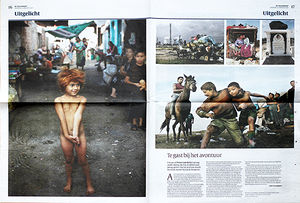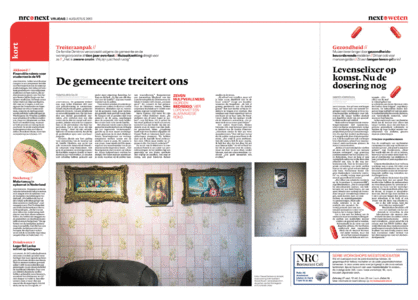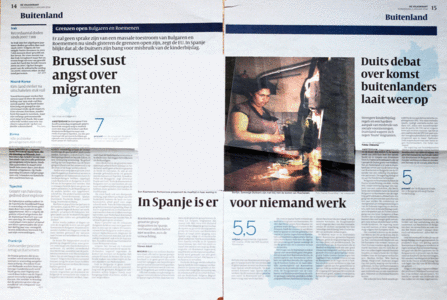User:Luisa Moura/writing/graduation/proposal draft: Difference between revisions
Luisa Moura (talk | contribs) No edit summary |
Luisa Moura (talk | contribs) No edit summary |
||
| Line 1: | Line 1: | ||
<div style='font-family:Courier,Sans;font-size:12px;color:#000000'> | <div style='font-family:Courier,Sans;font-size:12px;color:#000000'> | ||
[[File:LMoura volkskrant 01.JPG| | [[File:LMoura volkskrant 01.JPG|thumbnail]] | ||
==INTRODUCTION== | ==INTRODUCTION== | ||
Revision as of 00:47, 5 November 2014
INTRODUCTION
THE EXOTIC OTHER
The Exotic Other is a research on photojournalism, its mechanisms of representation and visual grammar. It attempts to reflect on the public detachment experienced upon images that are supposed to generate empathy and their failure to do so. The material collected refers to social and cultural concerns only, within the particular context of Dutch Media.
The public detachment towards sensitive pictures is part of an ongoing discussion regarding photojournalism and its nature. Does the Public see too much, does the Public see too little, does the Public sees “distortedly”? Is the Public numb from an excessive exposure to visual input and its violent nature? Could the Public actually act upon great part of this reality or is it impossible or too complicated to do so? (Sontag, Susan)
The detachment might also be related with an elementary dissonance in the process of experiencing empathy. Feeling empathy towards and individual or group implies the capacity of the observer to engage in the portrayed reality. The observer must be able to recognize on the “Other” “Himself” and imagine the feelings of threat, misery or fear upon his own skin. This is the natural phenomenon that allows one individual to be willing to act upon the reality of the other in order to erase an eminence of threat (Burke, Edmund).
What happens when the observer is kept in a state of permanent safety and power regarding the reality that he gets to be confronted with? Could empathy actually take place in this state of unbalanced relationship of power between the one who sees and the one who gets to be seen?
The research addresses phenomenon of detachment regarding the particular sphere of local social problems in the media. The lack of empathy regarding peers in the same social, economical and political sphere might have direct consequences on the exercise of citizenship. Lack of empathy, in the sense of lack of willingness to interfere, results on a weak sense of collectivity and might trigger social conflict.
Photography in itself, its visual grammar, plays an important role in this context. It provides a portrait of reality and defines what we are able to see and how we see it (Sontag, Susan). It can easily deepen or reduce the phenomenon of empathy towards the reality displayed by several means, from the choice of the subject portrayed to the very emotional impact of compositional factors: perspective, light, color, background, sharpness. Photography can easily render a familiar subject “exotic” by the simple means of representing it in a certain manner. Assuming that indeed we are less likely to feel empathy towards a reality that we cannot refer to as ours, the exoticizing of images can be a tool to increase feelings of social detachment and ultimately conflict.
This matter only invests itself of importance when particular methods of representation apply permanently to similar contents or individuals, establishing cognitive links in public imagery that go beyond the reality portrayed. In this circumstance intolerance, exclusion or indifference regarding a particular group or context might be perpetuated in a subtle and silent manner. Photography, as a structure of communication, must rely on public recognition of certain signals in order to make a message go through. Inevitably the public developed a visual knowledge regarding photographical input since its very invention and this shaped a mode of perception.
Photography created its own visual language, its own set of signs charged with meaning, typologies of representation. Some of them are more obvious than others. It is clear how an ID photograph should look like, or a family portrait, or an individual portrait, but there are also the informal typologies that developed with photojournalism: typologies of “truth” and “spontaneity”. Any theme is able to trigger public imagination regarding a possible photograph that could come along with it. We develop a visual memory that allows us to recognize a photograph as fitting a certain story or not. In the same way photographs can induce a critical attitude towards contents that might not even be associated with it. The pre-association of a visual grammar with certain contents shapes the way we relate to any further stimuli.
Photography is historically related with the broad establishment of institutions and with the control of the individual’s identity (XIX). The disciplinary control of citizens as governmental policy grew side by side with its representation in photographical medium (Tagg, John). These visual records allowed the definition of early typologies of individuals, mainly related with criminal or medical research, representing patterns of deviation. Anthropological tables were made getting together pictures of madmen, thieves or political dissidents. Conclusions were drawn upon it and there was an attempt to predict behavior patterns based in the way certain individuals would look like. Photography allowed a visual representation of categories and its authority relied greatly in its capacity to unveil truth. Framing of reality and its immediate association with a category or typology exist from the very beginning of photography institutional use. The word “category” has Greek origin and it meant “public accusation”. The first step to have a critical attitude towards a certain subject is its very objectification. Defining types, ordering reality in typologies or categories is precisely what allows judgment to be made upon it.
The Exotic Other is a research that attempts to deconstruct hypothetical typologies in contemporary photojournalism. This unfolding of charged meaning behind modes of representation intends to make use of comparative tables, tagging and literal deconstruction of photographs. Breaking patterns of visual perception, even if only for a moment, may allow a broader critical attitude regarding media content and meaning.
RELATION WITH PREVIOUS PRACTICE
Slums and the academicizing of poverty
The interest in this topic is related with a background in architecture and urban planning. It was triggered by studies on informal settlements and organic urban sprawl, often completed with photographs of the local inhabitants. The contrast between the highly academic level of these studies and the vulnerability of the people portrayed is usually stunning. And what is more surprising about it is that it feels like it couldn’t be otherwise. It is the “truth”. The question is: why does this “truth” need to be portrayed at all and why in this way? The fact that people in slums are too poor to defend themselves allows researchers to go through their houses, habits, deepest intimacy and set up an enlarging lens upon it for academic enjoyment. The humanist representation of these settlements and their people helps to frame them publicly onto something that can be worked on, at least that’s the purpose claimed by academics, but much too often just serves processes of gentrification. When confronted with the reality of the slums the public just tends to collect it as picturesque commodity and not act upon it at all.
Artist Impression
The imagery produced in the context of architectural practice is carefully constructed in order to trigger certain emotions, address tendencies or reach a particular group of people in order to sell the design, exactly like in marketing. The images are made up combining drawing, 3D renderings and photo manipulation. This play with photo collage is the most direct link between a previous practice and the present project proposal.
The Ideology of Self-Empowerment
The work developed early this year within the thematic seminar “Politics of Craft” brought about a new way to look at the relationship between feeling of power and lack of empathy. The installation presented diverse material relating an eminent end of the social state and the ideology of self-empowerment.
(…) We feel greatly empowered despite the increasing loss of security regarding work conditions, education, healthcare and cultural resources. It might be this sense of individual power that is greatly undermining our political criticism (…) Reality shows and documentaries on the decay of the welfare state like 'Tokkies' in the Netherlands and 'Benefits Street' in UK negatively depict the user of a social system, preparing the ground needed for political disruption and slashing of social rights. Stereotyping and blame are used to destroy empathy among individuals, rendering people apolitical and therefore vulnerable (…)
RELATION WITH BROADER CONTEXT
- Disciplinary mechanisms of control, identification, behavior constraints and permanent surveillance in line with the authority of photography as document. Bertillon. Parallel development of photography with the procedures of the Disciplinary Society XIX - XXI (PHELINE, Christian; TAGG, John; FOUCAULT, Michel)
- On-going discussion related with photojournalism and the exposure of pain, suffering, poverty and misery as commodities (SONTAG, Susan)
- Ideology, propaganda and control. Act of Killing / Enjoy Poverty (OPPENHEIMER / MARTENS, Renzo)
- Religious Iconography. The role of exposure for public judgment: between the punishment of the body and the ethics of disciplined behavior. The Patron Saints and the recognition of their authority as communication channels: typology, iconography, implicit narrative, repetition, litany.
PRACTICAL STEPS
Collect photographs from Dutch Media, kept in the context of their publication: newspaper spread, article. The choice for the Dutch media has only to do with the fact that it was necessary to circumscribe the limits of the research to a very specific context that I would feel most familiar with.
The format of "typological table" is kept as a reference to conduct the research. It establishes a Historical line with photography as an aggressive tool of documentation; aggressive in the sense that it tends to create typologies in order to create its own space as discipline. Being it in the field of art (curatorial choice for 'themes', see SONTAG), photojournalism (visual grammar of tragedy and poverty) or archival tool (ID, medical research, human database)
- Compare photographs and “tag” them: diverse selection from social / cultural contents
- Analyze and understand the visual grammar in use: composition, color, light and frame
- Deconstruct physically some photographs: play with elements | short process animations
- Practical photography exercise, make use of “typologies”: illustrated novel
(Dictionary)
(http://dictionary.reference.com)
Typology: a systematic classification or study of types.
Type: a number of things or persons sharing a particular characteristic, or set of characteristics, that causes them to be regarded as a group, more or less precisely defined or designated; class; category:
Category: any general or comprehensive division; a class (…) from the Greek “katēgoría” accusation (…) to accuse, affirm, literally, speak publicly against (…)
Exotic: of foreign nature or character; not native; introduced from abroad, but not fully naturalized or acclimatized.
Semiotics: the study of signs and symbols as elements of communicative behavior; the analysis of systems of communication, as language, gestures, or clothing.
REFERENCES
BARNEY, Matthew, “Prayer Sheet with the Wound and the Nail”, Schaulager-Hefte, 2010
BURKE, Edmund "A Philosophical Enquiry Into the Origin of Our Ideas of the Beautiful and the Sublime" Oxford World's Classics, 1998
FOUCAULT, Michel, “Discipline and Punish”, Penguin, 1991
FOUCAULT, Michel, “Madness &Civilization”, Vintage Books, 1988
FLUSSER, Vilém: http://www.youtube.com/watch?v=QFTaY2u4NvI: "television image and political space in the light of the Romanian revolution", 1990
FROMM, Erich, “The Fear of Freedom”, Routledge Classics, 2001
GRAHAM, Dan, “Dan Graham: works 1965-2000”, Richter Verlag, 2001
HALL, Edward T., “A Dimensão Oculta”, Editora Relógio d’ Água, 1986
HINE, Lewis, by Vicky Goldberg "Children at Work" Prestel - Munich, London, NYC 1999
KAFKA, Franz "A Hunger Artist" Twisted Spoon Press, Prague 2011
MACHIAVELLI, Nicolò, “O Príncipe”, Guimarães Editores, 2009
MOHOLY-NAGY, Lazló, "Painting, Photography, Film" Lund Humphries, London 1967
MUYBRIDGE, Eadweard "The human figure in motion" dover publications, inc., new york, 1955
PHÉLINE, Christian "L'image accusatrice" 17 - Cahiers de la photografie, 1985
SOBIESZEK, Robert A., "Ghost in the Shell – Photography and the Human Soul 1850-2001", Los Angeles County Museum of Art + MIT press, Cambridge Massachussets / London, England
SONTAG, Susan, “On Photography”, Penguin, 1984
SONTAG, Susan, “Regarding the Pain of Others”, Penguin, 2004
STEMMRICH, Gregor, “Dan Graham’s homes for America (1966): The Artist as Photojournalist and The Discovery of the Suburbs” in “Daidalos – architecture art culture” issue 66, December 1997
TAGG, John "The Burden of Representation - Essays on Photographies and Histories" Communications and Culture 1988



